Selecting the perfect cut of high-quality meat is key for exceptional BBQ spare ribs. Understanding rib anatomy and scoring techniques ensures juicy, tender results. Marinades and rubs add flavor and create a delicious crust. Mastering indirect heat cooking at 225-250°F (107-121°C) breaks down collagen for perfect tenderness. Using specific tools and a meat thermometer guarantees optimal results. Pairing the right sides and sauces completes the BBQ spare ribs experience. Present them hot on a platter with fresh herbs and sauce for an impressive spread.
Unleash your inner grill master with the ultimate guide to crafting mouthwatering BBQ spare ribs! From selecting the perfect cut of meat to mastering grilling techniques, this comprehensive article ensures every step is a delicious one. Learn how marinades and rubs elevate flavors, discover the art of slow cooking for tender ribs, and explore essential tools for consistent results. We’ll also guide you through side dishes and sauces that complete your BBQ spare ribs recipe, turning any gathering into a culinary celebration.
- Choosing the Right Cut of Ribs: Understanding Your Meat
- Marinades and Rubs: Unlocking Flavor Potential
- Grilling Techniques for Tender, Juicy Results
- The Art of Indirect Heat: Cooking Slowly and Evenly
- Essential Grill Tools for Perfect Ribs
- Monitoring Temperature and Doneness
- Pairing Sides and Sauces for a Complete Meal
- Tips for Staging and Serving Your BBQ Spare Ribs Recipe
Choosing the Right Cut of Ribs: Understanding Your Meat

When it comes to grilling succulent BBQ spare ribs, selecting the right cut is half the battle won. Opting for high-quality, meaty spares from a reputable butcher ensures a superior dining experience. Look for ribs with visible marbling—fatty streaks within the muscle—as this adds flavor and tenderness. The most common cuts include baby back and St. Louis-style spare ribs, each boasting unique characteristics. Baby backs have a smaller bone structure and more meat, making them ideal for individual portions. St. Louis spares, on the other hand, feature a larger bone that provides extra flavor and are perfect for sharing.
Understanding the anatomy of your ribs is key to mastering the BBQ spare ribs recipe. The meaty portion between the bone and the membrane (also known as the “silver skin” or “fatty cap”) is where most of the flavor develops during cooking. Before grilling, scoring or piercing the ribs can help render that fat, ensuring juicy, mouthwatering ribs. This simple step allows for better seasoning penetration and prevents the meat from drying out during the slow-cooking process, resulting in a tender, flavorful dish that will satisfy any barbecue enthusiast.
Marinades and Rubs: Unlocking Flavor Potential
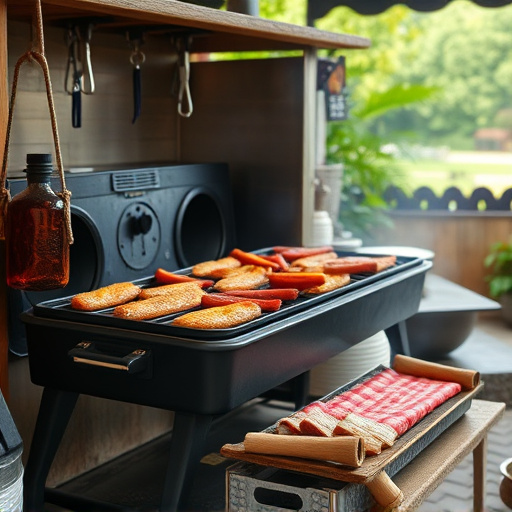
Marinades and Rubs: Unlocking Flavor Potential
When it comes to grilling perfect BBQ spare ribs recipes, marinades and rubs are your secret weapons. Marinades, with their combination of oils, acids, spices, and herbs, penetrate deep into the meat, tenderizing it while infusing flavors that transform your ribs from ordinary to extraordinary. These liquid golds can be as simple as a classic BBQ sauce or as complex as a blend of citrus, garlic, and chili powder.
Rubs, on the other hand, provide a burst of flavor at the surface of the ribs. Coating them with a generous sprinkle of spices like paprika, brown sugar, salt, pepper, and chili powder creates a savory crust that caramelizes during grilling, resulting in ribs that are both juicy and mouth-watering. Experimenting with different rub combinations allows you to customize your BBQ spare ribs recipe to suit your taste preferences, making each batch unique and irresistible.
Grilling Techniques for Tender, Juicy Results
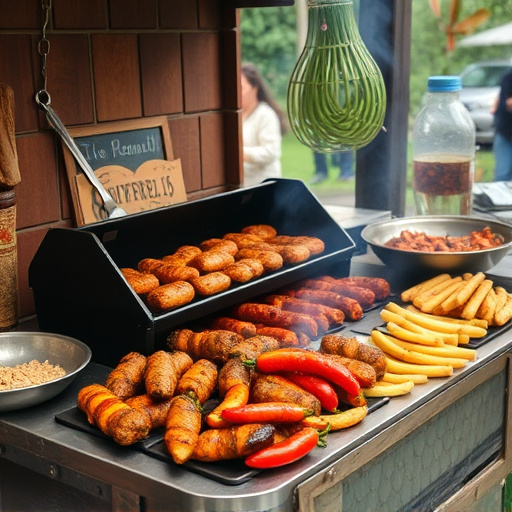
Mastering the art of grilling BBQ spare ribs involves a perfect blend of time, temperature, and technique. To achieve tender, juicy results with your bbq spare ribs recipe, start by preheating your grill to a consistent 225-250°F (107-121°C). This slow cooking allows the collagen in the ribs to break down, resulting in a melt-in-your-mouth texture. Use indirect heat, positioning the ribs away from the direct flame, to prevent charring and ensure even cooking.
Once cooked to an internal temperature of around 195-203°F (91-95°C), it’s time to apply a dry rub or barbecue sauce. This step adds flavor and helps seal in moisture. Brush on the sauce sparingly, allowing it to caramelize during the last few minutes of grilling. The key is patience; allow your spare ribs to rest for 10-15 minutes after removing them from the grill, letting the juices redistribute throughout the meat for maximum tenderness and juiciness.
The Art of Indirect Heat: Cooking Slowly and Evenly
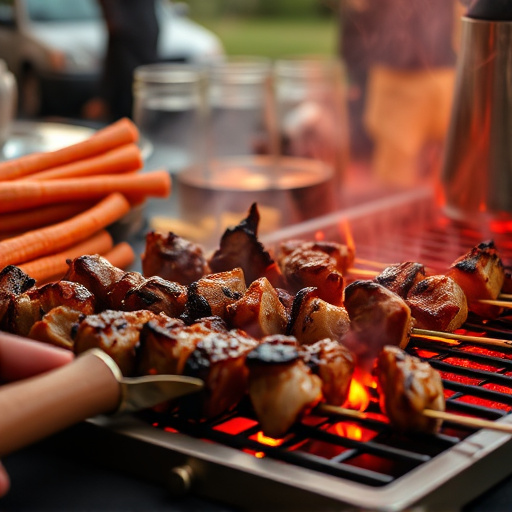
The key to cooking perfect BBQ spare ribs is mastering the art of indirect heat. This method involves cooking the ribs slowly and evenly, allowing them to become tender and succulent. Unlike direct heat, which can quickly char the exterior, indirect heat ensures a slow, consistent cook that breaks down the collagen in the meat, resulting in tender, flavorful ribs.
This technique typically requires using a lid on your grill or smoker, creating a sealed environment that retains heat and moisture. By controlling the temperature and managing the heat distribution, you can achieve a balanced cook. Slow and steady wins the race when it comes to grilling spare ribs, ensuring they reach their full potential as a mouthwatering BBQ favorite.
Essential Grill Tools for Perfect Ribs
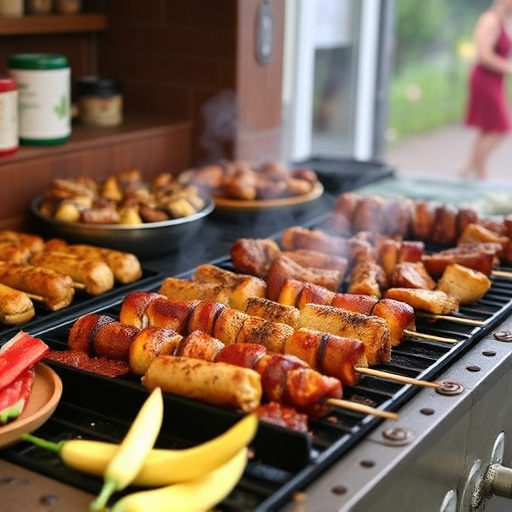
Achieving perfect BBQ spare ribs requires more than just a great recipe; it necessitates the right tools to ensure even cooking and mouthwatering results. Here are some essential grill tools that every serious barbecue enthusiast should have in their arsenal for tackling this classic BBQ dish.
A good quality, heavy-duty grill with reliable temperature control is non-negotiable. Look for features like a lid for smoke management and side burners for keeping sauces and sides warm. Additionally, invest in a meat thermometer to accurately monitor the internal temperature of your ribs, ensuring they’re cooked to perfection without overcooking or drying out. For flipping and moving ribs easily, a set of long-handled tongs is indispensable, while a butcher’s knife with a sharp blade comes in handy for trimming fat and making those delicious cuts.
Monitoring Temperature and Doneness
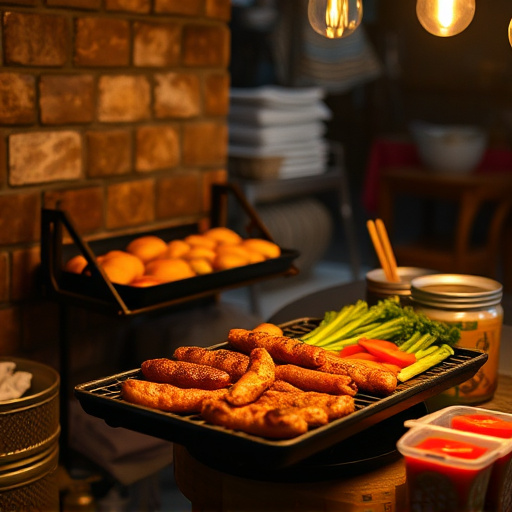
Monitoring the temperature of your grill and the doneness of your BBQ spare ribs recipe is crucial for achieving perfection. Use a reliable meat thermometer to ensure your ribs reach the ideal internal temperature of 195-203°F (90-95°C), indicating that they are fully cooked and tender. This precise monitoring allows you to avoid overcooking, which can dry out the ribs.
By keeping a close eye on both factors, you’ll be able to adjust your cooking time and heat accordingly, resulting in succulent, juicy spare ribs that simply melt in your mouth. Whether you’re using a charcoal or gas grill, maintaining control over these elements is key to crafting a mouthwatering BBQ spare ribs recipe.
Pairing Sides and Sauces for a Complete Meal
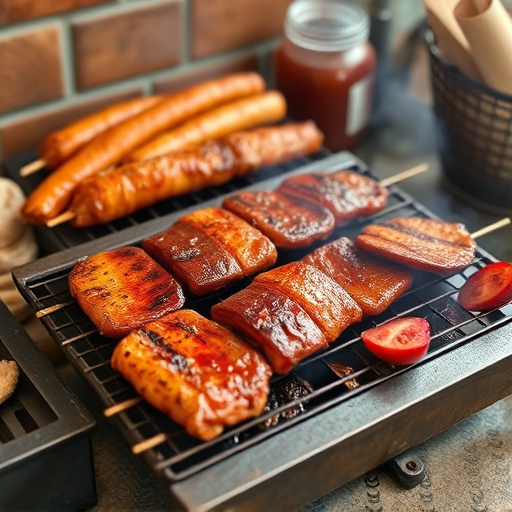
When it comes to grilling succulent BBQ spare ribs, pairing the right sides and sauces is essential for a complete meal experience. Start with a hearty base like coleslaw or baked beans, which offer a balance of textures and flavors that complement the tender ribs. Coleslaw’s crispness cuts through the richness of the ribs, while baked beans add a sweet and savory depth.
Don’t underestimate the power of sauces! A classic BBQ sauce is a must-have for any rib aficionado, offering a tangy sweetness that coats each bite perfectly. For a spicier kick, try a dry rub or a spicy sauce, which can enhance the smoky flavor of the ribs. Experimenting with different sides and sauces will elevate your BBQ spare ribs recipe to a whole new level, ensuring every mouthful is an unforgettable culinary journey.
Tips for Staging and Serving Your BBQ Spare Ribs Recipe
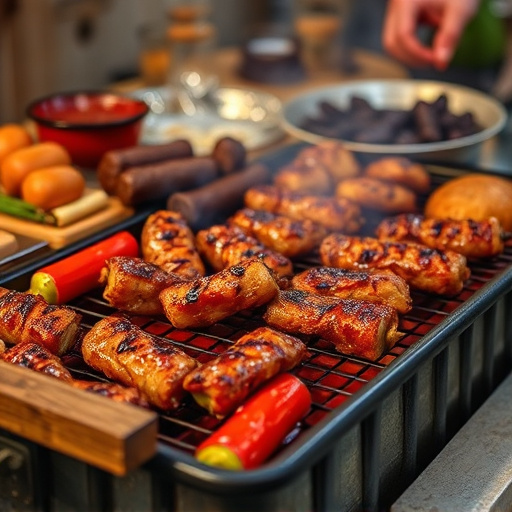
After cooking your mouth-watering BBQ spare ribs recipe, it’s time to stage and serve them with a show-stopping presentation. Start by arranging the ribs on a large platter or serving board, ensuring they are still hot to maintain their tenderness. Garnish with fresh herbs like parsley or cilantro, adding a pop of color and natural flavor. You can also drizzle some barbecue sauce over the top for an extra touch of moisture and sweetness. For serving, consider cutting the ribs into individual pieces to make it easier for guests to enjoy. Pair your delicious BBQ spare ribs recipe with classic side dishes such as coleslaw, cornbread, or baked beans to create a satisfying barbecue spread that’s sure to impress.
